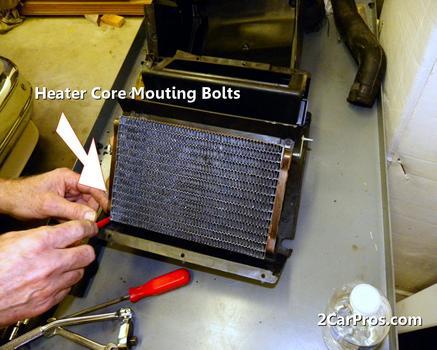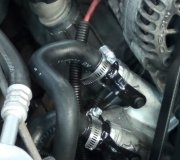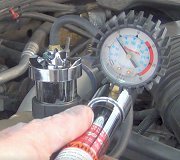Some mechanics have your wallet in mind and try to save you money. They believe they're doing right by you. Some mechanics have your best long-term interest at heart and want to take care of anything they see as a potential problem in the future. Both are hated by a lot of their customers. The first one gets blamed for everything that goes wrong with the car for almost the entire rest of its life, simply because he worked on it, (and "should have known this was going to happen"). The same people will blame him for trying to sell them more parts or services than they need. They don't understand how the complex machine they trust to get them back home works, and they don't understand that the mechanic is looking out for them long-term.
I can suggest a reasonable compromise. He is right about the radiator being just as old as the heater core, but there's more to the story.
Antifreeze will always be antifreeze, no matter how old it gets, but it's the additives that wear out in about two years, and that's why we replace it. Those include water pump lubricant, seal conditioners, and corrosion inhibitors. Acids naturally form in the coolant from combustion gases that sneak in through the cylinder head gasket. Any time you have two different metals and an acid, you have "galvanic action", (a fancy name for corrosion). That's what takes place in a flashlight battery. There's aluminum, steel, brass, lead, and tin in the cooling system so there's your different metals. When the additives in the coolant wear out, the acids start to act on the metal parts. This has been a REAL big problem on GM vehicles that use the red Dex-Cool antifreeze.
You can identify when this is happening by using an inexpensive digital voltmeter. Place one meter probe on ground, (the battery's negative post or any unpainted surface on the engine or body), then stick the other probe into the coolant in the radiator, but don't let it touch anything metal in there. If you read a voltage of more than about 2.0 volts, there is galvanic action taking place. It's common on GM vehicles to find 6.0 to 8.0 volts, and heater cores leaking in as little as five years. Repeat failures are also very common.
There's two reasons I would make you aware of the potential for the radiator to start leaking but I would not recommend replacing it. Explaining why it may start leaking takes care of my desire to look out for your long-term best interest, but I'll let you make that decision. First of all, most heater cores have to be designed in such a way that they promote debris settling in the bottom, and that's where the corrosion is usually at its worst. In fact, it's fairly common for casting sand left over from casting the engine block to accumulate there and keep the leak plugged, that is until the mechanic performs a maintenance cooling system flush and washes that sand out. Then you have a leak that shows up, and the mechanic gets blamed. Debris is much less likely to settle in the radiator, and corrosion takes place a lot more slowly there. Also, a lot of radiator tanks have been made of plastic for many years, and that's not going to be affected by the acids in the coolant. The radiator could last another five to eight years or more.
My second reason for not replacing the radiator is that is a relatively easy job. You really don't want to tackle a heater core yourself on any vehicle unless you know what is involved. You need the mechanic for that. However, if you know how to replace a radiator, you CAN usually do that yourself when it comes time for that. Even if you do have to go back to the mechanic, he isn't going to be repeating any of his previous work other than flushing and refilling the cooling system.
A timing belt and water pump driven by it are a better example. A common maintenance repair is replacing the timing belt. Typically that takes about six hours. All conscientious mechanics will want to replace the perfectly fine water pump at the same time to insure the quality of the repair. There's the added cost of the part, and perhaps another half hour of labor. Water pump failures are common. If yours fails a year after the timing belt was replaced, it is again going to be another six and a half hour repair, plus the damaged timing belt, and the potential for serious engine damage. Replacing the water pump up front is cheap insurance against a major future repair bill, and no reputable mechanic would suggest it not be replaced. Replacing the water pump months or years later means repeating every step of the timing belt repair a second time. That is not the case with your radiator.
As for aftermarket parts, I would guess that is what is used about 95 percent of the time on any repair. Many parts have standards that must be met and aftermarket parts will meet or exceed those standards. Engine sensors are a good example. We often see "pattern" failures, meaning it's real common to see the same failure over and over on certain car models. Some suppliers take original sensors apart to see what has been failing, then they design improvements to correct that. The car manufacturers are usually doing the same thing, so you might get an improved part through the dealer sooner than through a parts store. In the case of Chrysler, a part with an improvement will have a part number ending with "AA". After the next improvement, it will end with "AB". The highest you'll typically see is "AC" because by that time no more fixes are needed.
Also be aware that GM buys about 20 percent of their parts from outside suppliers, and they make the other 80 percent. Chrysler is just the opposite. They buy about 80 percent of their parts from manufacturers that specialize in making those products, and they have them perfected already. They only make about 20 percent of their own parts. Carter makes their fuel pump assemblies. They've been making carburetors and fuel pumps since at least the 1960s, and perhaps a lot longer than that. But, ... When the pumps come off the assembly line, one will get stamped with the Chrysler part number, and will be shipped to them, and the next one will be stamped with the NAPA part number and will be shipped to them. It's the same part, made in the same plant, with the same parts and quality. One is called "original equipment manufacturer", (OEM), and the other is called "aftermarket".
By the way, Chrysler buys a real lot of parts from Mitsubishi. Their Mitsubishi-built CD / cassette combo radios from the 1990s are by far some of the highest-quality radios you can buy. (You won't be tested on this later).
It is also real common to find far superior quality in aftermarket parts. I attended a class, then toured the Moog facility in Missouri a few years ago. In their research department they have strain sensors that are sensitive enough to be disturbed by a robin plucking a worm out of the ground 100 yards away! They are world-famous for their steering and suspension parts that are used by all NASCAR race teams. Those are the same parts we get for your vehicle. They are also rebranded for some other suppliers and auto parts chain stores. Ford has a real bad reputation for steering parts that separate leading to loss of control and crashes going back to the mid 1970s when some bean-counter figured out they could save 20 cents per car by leaving four grease fittings off. Moog designed the replacement parts the proper way. Even Ford mechanics don't want to use Ford steering parts.
GM had a problem with early wear in their rack and pinion steering gears in the 1980s. As is typical for them, the repair was designed to get the power steering assist back at the lowest possible cost to just get those cars out of the 50,000 mile warranty, then the proper fix had to be paid for by the owners when it happened again within just a few thousand miles. Moog designed the fix for that which is now used by all rebuilders in the industry. The $150.00 rebuilt rack assembly is far superior to the $500.00 original part. I'm not knocking the five hundred dollars. The only way you can buy a brand new steering gear is through the dealers, (for $500.00 to $600.00), but they are only used for in-warranty repairs when the manufacturer is paying the bill. Otherwise you only buy a rebuilt assembly. Those are also available from the manufacturer for about the same cost as from the auto parts stores.
Aftermarket parts like a radiator will often come with some type of quality assurance sticker showing which organization's standards they meet or comply with. You might even find a Mitsubishi logo molded into it someplace.
I could type for another hour, but my fingertips are smoking already! I'll continue on if you have more questions.
SPONSORED LINKS
Wednesday, October 15th, 2014 AT 11:40 PM




